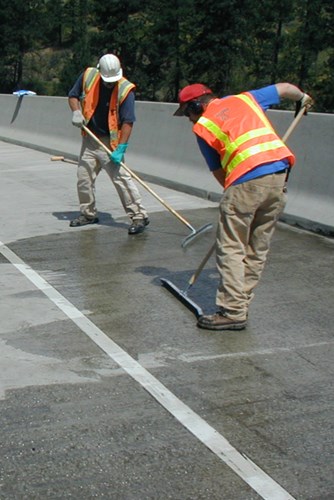As long as humans have been producing concrete,  there has been cracking and there have been two choices: avoid the cracks to begin with, or fix them later. Today, we have a plethora of ways to help avoid annoying cracks, or at the very least, keep them very small so that they are much less of a problem. We can do things such as use low- or zero-shrinkage concrete incorporating shrinkage-reducing or shrinkage-compensating admixtures, use low water/cement ratio concrete that incorporates water-reducing admixtures, do a better job of curing the concrete properly, add macro- and/or microfibers to the concrete, use evaporation retarders, and perform saw-cutting operations as soon as possible with early-entry saws.
there has been cracking and there have been two choices: avoid the cracks to begin with, or fix them later. Today, we have a plethora of ways to help avoid annoying cracks, or at the very least, keep them very small so that they are much less of a problem. We can do things such as use low- or zero-shrinkage concrete incorporating shrinkage-reducing or shrinkage-compensating admixtures, use low water/cement ratio concrete that incorporates water-reducing admixtures, do a better job of curing the concrete properly, add macro- and/or microfibers to the concrete, use evaporation retarders, and perform saw-cutting operations as soon as possible with early-entry saws.
When cracks do happen, there have been three ways to treat cracks that are typically in the 0.01 to 0.06 in. (10 to 60 mils) width range. One way is to use waterproofing coatings that are usually acrylic-based. If properly applied, these coatings will seal the concrete but do not penetrate into the cracks to heal them or the concrete. They have the disadvantage of being “on” the surface, which means that any physical abuse will wear them “off” the surface. Coatings obviously do no good once they wear off.
Another common method of treating concrete cracks is to use penetrating water repellents. They are usually silane, siloxane, or a silane/siloxane blend. They soak into the crack and coat the sides to provide a water-repellent barrier, but they do not heal the concrete.
Finally, there are crack healer/sealers, which have typically been methyl methacrylate, high molecular weight methacrylate, urethane, or epoxy. When properly formulated and used, these have the advantage of filling the cracks to provide both sealing and healing of the concrete. Furthermore, because they penetrate, they do not wear off the concrete surface. Healer/sealers have been around for decades, but their ability to fully fill, seal, and heal cracks often yielded mixed results. When healer/sealers were first developed, it was easy to look at the viscosity of the resin as the culprit for these mixed outcomes. If the viscosity was too low, it would flow into the crack and right out the bottom of the slab or structural member. If the viscosity was too high, it didn’t penetrate far enough to fill the crack. However, the viscosity of the resin wasn’t the only property that contributed to the less than stellar performance of the first healer/sealers.
When it came time to develop a new generation of healer/sealers, the biggest challenge was to formulate one that filled the cracks and kept them filled. Research showed fairly quickly that it wasn’t all about the material viscosity. Other factors, also had to be considered, including the method used to achieve the desired viscosity, modulus of elasticity, dynamic surface tension, and safety of handling.
VISCOSITY
The optimum mixed viscosity was determined to be ultra-low, in the 80 to 120 cP (80 to 120 mPa-s) range. However, it was also discovered that the means used to achieve the viscosity were just as important as the viscosity itself. That’s where molecular weight distribution comes into play. An optimized molecular weight distribution allows the viscosity of the healer/sealer to be modified while maintaining its desirable physical properties.
MODULUS OF ELASTICITY
The benefits of a low modulus healer/sealer cannot be disputed. A low modulus resin will be more flexible and thus perform much better in conditions where mechanical or thermal movement is likely. Because a majority of treated cracks are on concrete bridges and parking decks, a low modulus of elasticity resin is optimal. This type of resin will seal and heal the crack, bind the crack back together, and yet allow a certain amount of movement so as to prevent re-cracking.
DYNAMIC SURFACE TENSION
Low surface tension is an important factor in allowing the healer/sealer to penetrate into concrete cracks. The new generation of healer/sealers was formulated using specially designed surface tension reducing agents, which allows the healer/sealer resin to penetrate into the cracks more readily.
THE PROOF IS IN THE PROPERTIES OF CONCRETE TREATED WITH NEW GENERATION HEALER/SEALERS
They heal:
- Abrasion resistance (ASTM C 779) — 7 day old specimen abraded for 60 minutes: 90.2% improvement. This means that the abrasion resistance increased by a factor of 10 and in the time it would take for just 0.01 in. (10 mils) to wear away from the healed/sealed concrete surface, there would have been 0.10 in. (100 mils) worn away from untreated concrete.
They seal:
- Absorption (ASTM C 413) — 89.7% improvement. This means that the absorption was only one-tenth that of the untreated concrete.
- Acid-soluble chloride (AASHTO T 259/T 260): 100% improvement. That means that the penetration of acid-soluble chlorides went to zero.
Learn more about Euclid Chemical’s methyl methacrylate healer sealer - DURAL MMA HEALER/SEALER.